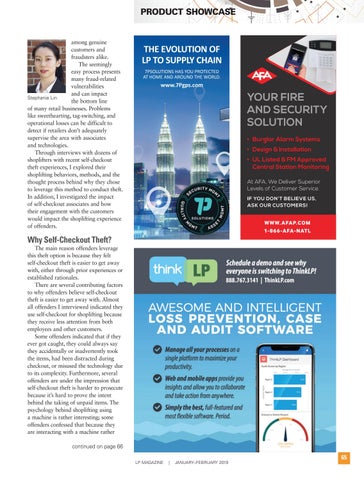PRODUCT SHOWCASE
among genuine customers and fraudsters alike. The seemingly easy process presents many fraud-related vulnerabilities and can impact Stephanie Lin the bottom line of many retail businesses. Problems like sweethearting, tag-switching, and operational losses can be difficult to detect if retailers don’t adequately supervise the area with associates and technologies. Through interviews with dozens of shoplifters with recent self-checkout theft experiences, I explored their shoplifting behaviors, methods, and the thought process behind why they chose to leverage this method to conduct theft. In addition, I investigated the impact of self-checkout associates and how their engagement with the customers would impact the shoplifting experience of offenders.
THE EVOLUTION OF LP TO SUPPLY CHAIN 7PSOLUTIONS HAS YOU PROTECTED AT HOME AND AROUND THE WORLD.
www.7Pgps.com
2019
Product Showcase and Resource Guide
Why Self-Checkout Theft?
The main reason offenders leverage this theft option is because they felt self-checkout theft is easier to get away with, either through prior experiences or established rationales. There are several contributing factors to why offenders believe self-checkout theft is easier to get away with. Almost all offenders I interviewed indicated they use self-checkout for shoplifting because they receive less attention from both employees and other customers. Some offenders indicated that if they ever got caught, they could always say they accidentally or inadvertently took the items, had been distracted during checkout, or misused the technology due to its complexity. Furthermore, several offenders are under the impression that self-checkout theft is harder to prosecute because it’s hard to prove the intent behind the taking of unpaid items. The psychology behind shoplifting using a machine is rather interesting; some offenders confessed that because they are interacting with a machine rather continued on page 66 LP MAGAZINE
|
JANUARY–FEBRUARY 2019
65










